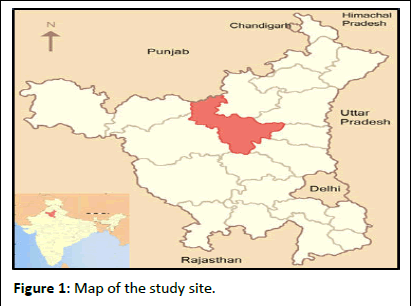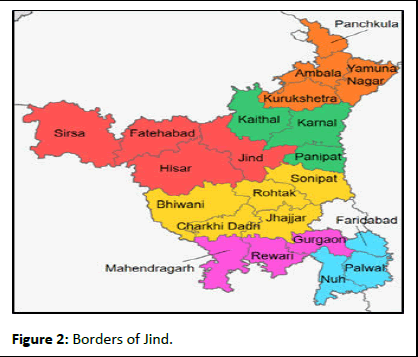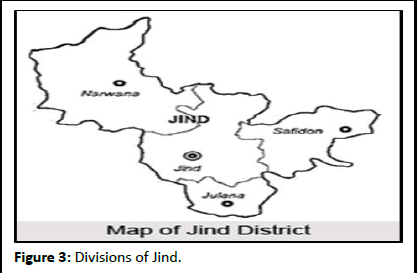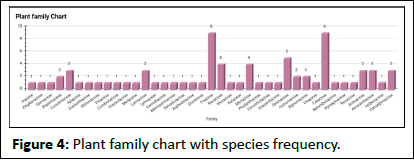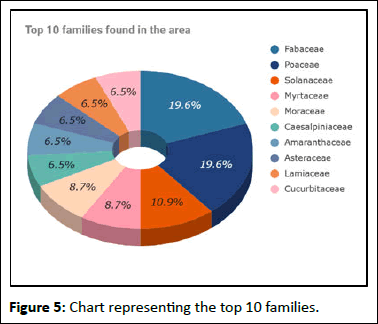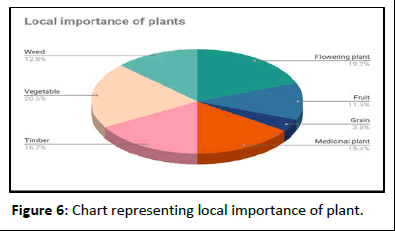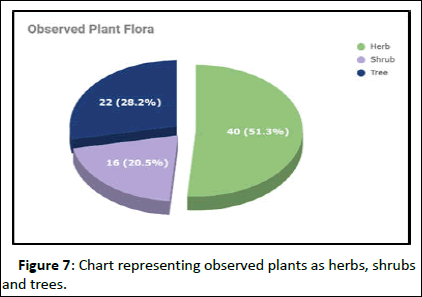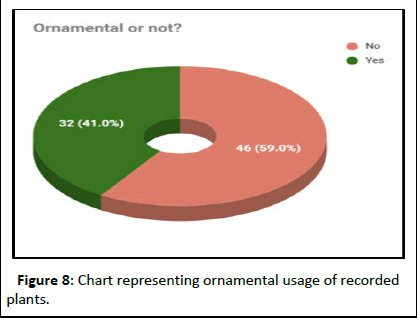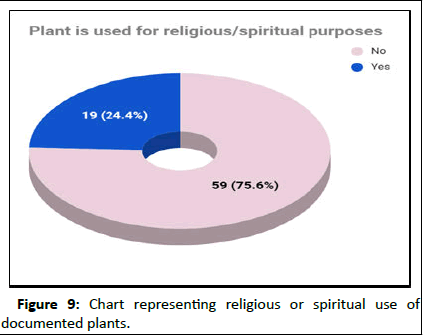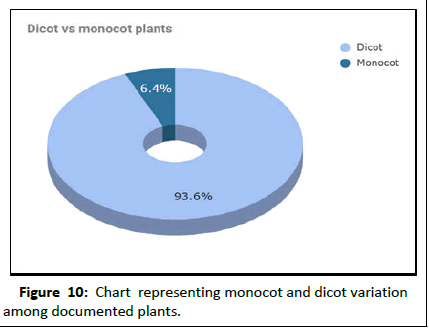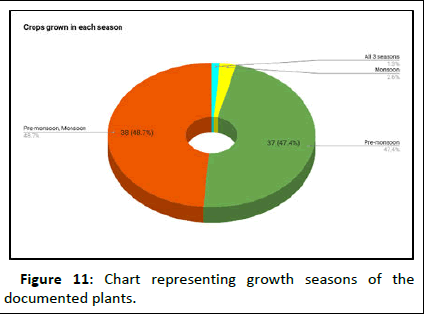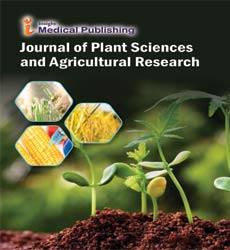Exploring Indigenous Plant Species of Jind District: Utilization, Characteristics and Cultural Significance in a Specific Region
Abhishek1*, Chanchal Malhotra1 and Riti Thapar Kapoor2
1Department of Botany, Baba Mastnath University, Rohtak, Haryana, India
2Department of Biotechnology, Amity University, Uttar Pradesh, India
- *Corresponding Author:
- Abhishek
Department of Botany, Baba Mastnath University, Rohtak, Haryana, India
E-mail:abhi7861008@gmail.com
Received date: December 16, 2023, Manuscript No. IPJPSAR-23-18208; Editor assigned date: December 19, 2023, PreQC No. IPJPSAR-23-18208 (PQ); Reviewed date: January 04, 2024, QC No. IPJPSAR-23-18208; Revised date: February 07, 2025, Manuscript No. IPJPSAR-23-18208 (R); Published date: February 15, 2025, DOI: 10.36648/ipjpsar.9.1.169
Citation: Abhishek, Malhotra C, Kapoor RT (2025) Exploring Indigenous Plant Species of Jind District: Utilization, Characteristics and Cultural Significance in a Specific Region. J Plant Sci Agri Res Vol:9 No:1
Abstract
Aim: The current investigation is aimed at comprehensive analyses of indigenous plant species of Jind district, focusing on their uses, characteristics and cultural importance in a specific region.
Method: Field visits spanned all 4 subdivisions of Jind district-Jind, Narwana, Safidon, and Uchana embracing diverse cultural and socioeconomic contexts. The methodology involved one-on-one interviews, employing structured questionnaires and open-ended queries, capturing varied insights on traditional practices, beliefs, seasonal plant reproduction and local challenges.
Results: Results showcase diverse plant families, with Fabaceae and Poaceae being the most prevalent (9 species each). Solanaceae, Myrtaceae, Moraceae and others feature prominently. Utilization patterns vary, including 20.5% as vegetables, 15.4% with medicinal properties, 16.7% for timber, 11.5% for nutrition, and 75.6% for religious/spiritual purposes. Botanical composition highlights dicotyledonous dominance of 93.6% and with 6.4% monocotyledonous. Crop cycles correlate with pre-monsoon and monsoon seasons, influencing pollination and resilience. Plants serve ornamental roles and cultural/spiritual functions.
Conclusions: Conservation and promotion benefit ecology and resource efficiency. This research underscores the need for awareness, conservation and sustainable use, securing their role in the community's fabric. Plants from various families, primarily Fabaceae and Poaceae, are significantly utilized for different purposes, emphasizing the multifaceted role of indigenous flora in the region's ecology, culture and economy. Conservation efforts are crucial to preserving these plants and their significance in the community.
Keywords
Biodiversity; Heritage; Culture; Economy
Introduction
Biodiversity's effects vary across different environments and systems, but global food trends can harm it. To fully integrate biodiversity into food production, we need a holistic approach that goes beyond just productivity. The World Health Organization (WHO) acknowledges the significant role of plant based traditional medicine in achieving its health objectives. In rural India, 65% of the population relies on traditional medicinal plants for primary healthcare. Ethnobotanical knowledge, derived from over 7,500 plant species, holds great promise in drug development for various human diseases. Cultural values strongly influence people's decisions, including in science. Quantifying qualitative data is vital for preserving diverse plant species. This requires using both qualitative and quantitative methods, like interviews and group discussions. Ethnobotanical research studies show how different ethnic groups interact with plants, revealing historical connections. Protecting this cultural knowledge is crucial for biodiversity and sustainable development. Herbal medicines too have been important for centuries, and they're making a comeback due to safety concerns. Combining indigenous knowledge and scientific research, community based participatory research involves collaboration between researchers and stakeholders. It aims to create actionable insights and involves those who can apply f indings. This approach is valuable for social change, but bridging researchers and communities can be challenging. Ethnopharmacological heritage of the indigenous communities in Udhampur district, Jammu and Kashmir, India was studied through interviews with 182 local informants; it documents 166 medicinal plant species from diverse families and highlights their use in treating 78 ailments. The study identifies key medicinal plants. Because of their enduring connection with forests, ethnic communities possess a vast reservoir of plant lore and folklore, which they receive and transmit across generations solely through oral tradition.
The northern region of India boasts a wealth of medicinal f lora, with 1,748 out of the 8,644 plant species documented in the Indian Himalaya recognized for their medicinal significance.
Modern plant taxonomy is built upon the system developed by the distinguished Swedish physician and botanist, Carl Von Linné, later known as Carlos Linnaeus. His approach centers on studying a plant's flowers and reproductive structures, which are less affected by changing environments, making his system highly reliable. Grouping plants based on similar botanical traits is key to understanding their relationships. Close relatives often face similar pest challenges. Botanical resemblances also provide insights into factors like a plant's lifespan and its reactions to specific environments.
Limited information exists regarding the seasonal variability of plant species within the Jind district. Prior investigations predominantly concentrate on the utilitarian aspects of plants, particularly their applications in food and medicinal contexts. In this study, our objective was to survey the Jind district and collect and record information about the months of reproductive activity, ascertain their utilization within religious or spiritual contexts, and elucidate the manner in which these plants are used by the natives. This information holds the potential to shed light on the indispensability of these plant species and subsequently develop conservation strategies [1]
Materials and Methods
Study area
The state of Haryana of India has 22 districts; Jind being one of them. The district's administrative centre is Jind town (Figure 1). Geographically, it lies between 29.03' and 29.51' North latitude and 75.53' and 76.47' East longitude (district administration, 2023a). The climate is dry with hot summers and cold winters. Rainfall averages 55 cm annually, with 70% during July to September. July and August bring over 50% of the yearly rainfall. In June, max temperature is about 41°C, and min temperature is about 27°C. Hot winds during the hot season can be tiring. The semi-arid, tropical climate sees temperatures exceeding 41°C in May-June and dropping to 6°C in winter. Rainfall averages 515 mm, mainly in July-September, with some in December-February. August gets the most rain. Jind shares borders with Patiala (North), Sangrur (Northeast), Kaithal (East), and Karnal (West) (Figure 2) [2].
Figure 1: Map of the study site.
Figure 2: Borders of Jind.
In the demarcation of administrative regions, the district of Jind is systematically divided into four distinct sub-divisions, namely Jind, Narwana, Safidon, and Uchana (Figure 3). Furthermore, it is imperative to elucidate that Jind, as a district, is characterized by the presence of five Vidhan Sabha constituencies. These constituencies are known as Julana, Safidon, Jind, Uchana Kalan, and Narwana [3].
Figure 3: Divisions of Jind.
The survey was conducted in the Jind district of Haryana in the year 2021-2022. The field visits were conducted in all the 4 subdivisions of the districts individually Jind, Narwana, Safidon, and Uchana, covering a wide range of geographical, cultural, and socioeconomic contexts. The methodology involved engaging in one-on-one interviews with local individuals from different walks of life. These interactions aimed to explore their experiences, traditional practices, and beliefs, as well as to gain an understanding of their challenges and aspirations. During the interviews, a structured questionnaire was utilized as a guide, ensuring consistent data collection across different locations. Open-ended questions were also incorporated to encourage participants to share personal anecdotes and unique insights. The collected data encompassed a diverse range of topics, including traditional knowledge and cultural practices and seasons of reproduction of the plants [4].
In the course of this extensive survey, a cohort of 105 individuals was subjected to interviews. Approximately 26 individuals were judiciously selected from each of the subdivisions under investigation, with each participant contributing invaluable insights pertaining to 2 to 3 distinct plant species. To confer significance to the gathered data, a criterion was established where concurrence across more than 3 respondents, affirming identical information concerning a particular plant species, was deemed noteworthy. Data was systematically collected for a total of 78 distinct plant species as part of the comprehensive survey conducted. We identified the scientific names of each plant by using the book "A pictorial guide to common garden plants." This book contains basic information about more than 200 ornamental plant species and varieties grown in North Indian gardens. It presents the information in a way that is easy to understand for both beginners and experts in the field [5].
The assemblage of photographic materials, along with the accompanying herbarium (field notebook), which comprehensively documents the indigenous plant species identified and recommended by the study's respondents, has been formally deposited within the institutional archives of the university.
Results
The information collected by the survey has been presented in Table 1 where the local names of the plant along with its scientific names have been presented along with its family name. Additionally, the table records the indigenous applications of the plants, their categorization as observed within the local plant flora, usage of their ornamental nature, or their utilization for religious or spiritual purposes. Details, such as the reproductive months and the classification of seeds, have been noted as well. Furthermore, the Indian seasonal classification, derived from the data collected by the natives, has been incorporated into the presentation. Two families were found to be the most represented families in the area which were Fabaceae and Poaceae with 9 species each. They were followed by families Solanaceae (5 species), Myrtaceae (4 species), Moraceae (4 species), Caesalpiniaceae (3 species), Amaranthaceae (3 species), Asteraceae (3 species), Lamiaceae (3 species), Cucurbitaceae (3 species), Bignoniaceae (2 species), Apocynaceae (2 species), Brassicaceae (2 species), etc. (Figure 4) [6].
| Family | No. of plants | Percentage | Rank |
| Fabaceae (Legume family) | 9 | 19.6% | 1 |
| Poaceae (Grass family) | 9 | 19.6% | 2 |
| Solanaceae (Nightshade family) | 5 | 10.9% | 3 |
| Myrtaceae (Myrtle family) | 4 | 8.7% | 4 |
| Moraceae (Mulberry family) | 4 | 8.7% | 5 |
| Caesalpiniaceae (Senna family) | 3 | 6.5% | 6 |
| Amaranthaceae (Amaranth family) | 3 | 6.5% | 7 |
| Asteraceae (Aster family) | 3 | 6.5% | 8 |
| Lamiaceae (Mint family) | 3 | 6.5% | 9 |
| Cucurbitaceae (Cucumber family) | 3 | 6.5% | 10 |
Table 1: Observed top 10 families in the area.
Figure 4: Plant family chart with species frequency.
The top 10 most prominent plant families found in the area are Fabaceae, commonly known as the legume family; Poaceae, representing the grass family; Solanaceae, recognized as the nightshade family; Myrtaceae, the myrtle family; Moraceae, which denotes the mulberry family; Caesalpiniaceae, pertaining to the Senna family; Amaranthaceae, associated with the amaranth family; Asteraceae, representing the aster family; Lamiaceae, known as the mint family; and inally, Cucurbitaceae, signifying the cucumber family (Table 1). The number of plants for each family is denoted in Figure 5 [7].
Figure 5: Chart representing the top 10 families.
In consideration of indigenous utilization patterns pertaining to the plants under investigation (Tables 2 and 3), it was observed that 20.5% of the documented flora was used as vegetables. A proportion of 19.2% comprised species categorized as flowering plants. Additionally, 16.7% of the catalogued plants exhibit characteristics conducive to timber production, thereby contributing to the local forestry sector. Notably, 15.4% of the plants were harnessed for their medicinal properties, serving therapeutic functions within the community. Intriguingly, 12.8% of the flora encompassed species designated as weeds, often regarded as undesirable due to their encroachment upon cultivated areas. Furthermore, 11.5% of the plants consisted of fruit bearing species, contributing to nutritional sustenance. Lastly, a minor percentage, 3.8%, pertains to plants utilized in the form of grains, accentuating their role in the local diet (Figure 6) [8].
| Sl. no | Local name | Botanical name | Family | Local usage | Observed plant flora | Ornamental? | Used for religious/spiritual purpose? | Seed type | Reproductive months |
| 1 | Amaltash | Cassia fistula | Caesalpiniaceae | Flowering plant | Tree | Yes | No | Dicot | May-July |
| 2 | Bhangri | Clerodendrum indicum | Verbenaceae | Flowering plant | Shrub | Yes | No | Dicot | April-June |
| 3 | Lalmurga | Celosia cristata | Amaranthaceae | Flowering plant | Herb | Yes | No | Dicot | May-July |
| 4 | Gulbahar | Bellis perennis | Asteraceae | Flowering plant | Shrub | Yes | No | Dicot | April-July |
| 5 | Garden dahlia | Dahlia pinnata | Asteraceae | Flowering plant | Herb | Yes | No | Dicot | May-October |
| 6 | Gulaab | Rosa damascene | Rosaceae | Flowering plant | Shrub | Yes | Yes | Dicot | May-August |
| 7 | Kaagaj ka phool | Bougainvillea spectabilis | Nyctaginaceae | Flowering plant | Herb | Yes | No | Dicot | May-August |
| 8 | Kamal | Nelumbo nucifera | Nelumbonaceae | Flowering plant | Shrub | Yes | Yes | Dicot | April-June |
| 9 | Karanja/Karanj | Pongamia pinnata | Fabaceae | Flowering plant | Tree | No | No | Dicot | April-June |
| 10 | Genda | Tagetes erecta | Asteraceae | Flowering plant | Shrub | Yes | Yes | Dicot | July-September |
| 11 | Mogra | Jasminum sambac | Oleaceae | Flowering plant | Shrub | Yes | Yes | Dicot | April-June |
| 12 | Neem chameli | Millingtonia hortensis | Bignoniaceae | Flowering plant | tree | No | No | Dicot | April-June |
| 13 | Tagar/Chandni | Tabernaemontana divaricate | Apocynaceae | Flowering plant | Shrub | Yes | Yes | Dicot | July-September |
| 14 | Raat rani | Cestrum nocturnum | Solanaceae | Flowering plant | Shrub | Yes | No | Dicot | April-June |
| 15 | Sadabahar | Catharanthus roseus | Apocynaceae | Flowering plant | Shrub | Yes | Yes | Dicot | April-June |
| 16 | Aam | Mangifera indica | Anacardiaceae | Fruit | Tree | No | Yes | Dicot | March-June |
| 17 | Amarbel | Cuscuta reflexa | Convolvulaceae | Fruit | Herb | No | No | Dicot | April-September |
| 18 | Amla | Phyllanthus emblica L. | Phyllanthaceae | Fruit | Tree | No | No | Dicot | April-June |
| 19 | Amrood | Psidium guajava | Myrtaceae | Fruit | Tree | No | Yes | Dicot | April-August |
| 20 | Bael patthar | Aegle marmelos | Rutaceae | Fruit | Tree | No | Yes | Dicot | April-August |
| 21 | Kela | Musa sp | Musaceae | Fruit | Herb | No | Yes | Monocot | April-June |
| 22 | Bedu | Ficus palmata | Moraceae | Fruit | Tree | No | No | Dicot | March-May |
| 23 | Jamun | Syzygium cumini L. | Myrtaceae | Fruit | Tree | Yes | No | Dicot | March-May |
| 24 | Shahtoot | Morus alba | Moraceae | Fruit | Tree | No | No | Dicot | April-May |
| 25 | Bajra | Pennisetum glaucum | Poaceae | Grain | Shrub | No | No | Monocot | April-September |
| 26 | Khoi/Izkhar | Cymbopogon jwarancusa J. | Gramineae | Grain | Herb | No | No | Monocot | April-May |
| 27 | Makka | Zea mays L. | Poaceae | Grain | Herb | No | No | Monocot | April-May |
| 28 | Gwar Patha/Ghrit kumari | Aloe vera | Asphodelaceae | Medicinal plant | Herb | No | No | Monocot | March-April |
| 29 | Ashwagandha | Withania somnifera | Solanaceae | Medicinal plant | Herb | No | No | Dicot | April-June |
| 30 | Bada peelu | Salvadora oleoides | Salvadoraceae | Medicinal plant | Shrub | No | No | Dicot | March-April |
| 31 | Datura | Datura innoxia Mill. | Solanaceae | Medicinal plant | Herb | No | Yes | Dicot | April-July |
| 32 | Giloy | Tinospora (L.)M. | Menispermaceae | Medicinal plant | Herb | No | No | Dicot | April-May |
| 33 | Bhang | Cannabis sativa | Cannabaceae | Medicinal plant | Herb | No | Yes | Dicot | April-July |
| 34 | Henna | Lawsonia inermis | Lythraceae | Medicinal plant | Shrub | No | Yes | Dicot | March-July |
| 35 | Kali tulsi | Ocimum basilicum L. | Lamiaceae | Medicinal plant | Herb | No | Yes | Dicot | April-June |
| 36 | Mulethi | Glycyrrhiza glabra | Fabaceae | Medicinal plant | Herb | No | No | Dicot | April-June |
| 37 | Neem | Azadirachta indica | Meliaceae | Medicinal plant | Tree | No | No | Dicot | April-May |
| 38 | Patharchatta | Bryophyllum calycinum | Crassulaceae | Medicinal plant | Herb | No | No | Dicot | April-June |
| 39 | Tulsi | Ocimum tenuiflorum | Lamiaceae | Medicinal plant | Shrub | No | Yes | Dicot | April-June |
| 40 | Arjun | Terminalia arjuna | Combretaceae | Timber | Tree | No | No | Dicot | April-June |
| 41 | Babool | Acacia arabica | Fabaceae | Timber | Tree | No | No | Dicot | April-May |
| 42 | Bargad | Ficus benghalensis | Moraceae | Timber | Tree | No | Yes | Dicot | April-May |
| 43 | Devdaru | Cedrus deodara | Pinaceae | Timber | Tree | No | No | Dicot | April-May |
| 44 | Gulmohar | Delonix regia | Caesalpiniaceae | Timber | Tree | Yes | No | Dicot | April-May |
| 45 | Bruhat | Cenchrus biflorus | Poaceae | Timber | Herb | Yes | No | Dicot | April-May |
| 46 | Khejri | Prosopis cineraria | Mimosaceae | Timber | Tree | Yes | No | Dicot | April-May |
| 47 | Kikar | Vachellia nilotica | Fabaceae | Timber | Herb | Yes | No | Dicot | April-May |
| 48 | Pipal | Ficus religiosa | Moraceae | Timber | Tree | Yes | Yes | Dicot | April-May |
| 49 | Roheda/Marwar Teak | Tecomella undulata | Bignoniaceae | Timber | Tree | Yes | No | Dicot | April-May |
| 50 | Safeda/Eucalyptus | Eucalyptus globulus | Myrtaceae | Timber | Herb | Yes | No | Dicot | April-May |
| 51 | Shisham | Dalbergia sissoo | Fabaceae | Timber | Tree | Yes | No | Dicot | April-May |
| 52 | Siris | Albizia lebbeck (L.) Benth. | Fabaceae | Timber | Tree | Yes | No | Dicot | April-May |
| 53 | Badi Dudhi | Euphorbia hirta | Euphorbiaceae | Vegetable | Herb | No | No | Dicot | April-August |
| 54 | Baingan | Solanum melongena | Solanaceae | Vegetable | Herb | No | No | Dicot | April-June |
| 55 | Bathua | Chenopodium album L. | Amaranthaceae | Vegetable | Herb | No | No | Dicot | April-May |
| 56 | Dhaniya | Coriandrum sativum | Apiaceae | Vegetable | Herb | No | No | Dicot | April-May |
| 57 | Imli | Tamarindus indica | Caesalpiniaceae | Vegetable | Tree | No | No | Dicot | April-June |
| 58 | Kharbuja | Cucumis melo L. | Cucurbitaceae | Vegetable | Herb | No | No | Dicot | April-June |
| 59 | Kundru | Coccinia grandis | Cucurbitaceae | Vegetable | Herb | No | No | Dicot | April-August |
| 60 | Methi | Trigonella foenum-graecum | Fabaceae | Vegetable | Herb | No | No | Dicot | April-May |
| 61 | Muli | Raphanus sativus | Brassicaceae | Vegetable | Herb | No | No | Dicot | April-June |
| 62 | Palak | Spinacea oleracea L. | Amaranthaceae | Vegetable | Herb | No | No | Dicot | April-May |
| 63 | Papita | Carica papaya | Caricaceae | Vegetable | Shrub | No | No | Dicot | April-May |
| 64 | Pudina | Mentha piperita L. | Lamiaceae | Vegetable | Herb | No | No | Dicot | April-May |
| 65 | Sarson | Brassica juncea | Brassicaceae | Vegetable | Herb | No | No | Dicot | April-May |
| 66 | Tamatar | Solanum lycopersicum | Solanaceae | Vegetable | Herb | No | No | Dicot | April-June |
| 67 | Tori | Luffa acutangula | Cucurbitaceae | Vegetable | Herb | No | No | Dicot | April-August |
| 68 | Kacchi haldi | Curcuma longa Linn | Zingiberaceae | Vegetable | Herb | No | Yes | Dicot | April-June |
| 69 | Kans grass | Saccharum spontaneum | Poaceae | Weed | Herb | No | No | Dicot | April-May |
| 70 | Bottlebrush | Callistemon lanceolatus | Myrtaceae | Weed | Shrub | Yes | No | Dicot | April-June |
| 71 | Chui-Mui | Mimosa pudica L | Fabaceae | Weed | Herb | Yes | No | Dicot | April-May |
| 72 | Dhoob | Cynodon dactylon | Poaceae | Weed | Herb | Yes | Yes | Dicot | April-May |
| 73 | Dhaman ghass | Cenchrus ciliaris L. | Poaceae | Weed | Herb | Yes | No | Dicot | April-May |
| 74 | Money plant | Epipremnum aureum | Araceae | Weed | Herb | Yes | No | Dicot | April-May |
| 75 | Baruwa ghass | Erianthus munja R. | Poaceae | Weed | Herb | Yes | No | Dicot | April-May |
| 76 | Guria Ghass | Chrysopogon fulvus | Poaceae | Weed | Herb | Yes | No | Dicot | April-May |
| 77 | Rigid Needle Grass | Aristida hystrix | Poaceae | Weed | Herb | Yes | No | Dicot | April-May |
| 78 | Sarphonk/Sharpunkha/Masa | Tephrosia spp (L.) P. | Fabaceae | Weed | Shrub | Yes | No | Dicot | April-May |
Table 2: Data collected in botanical survey.
| No. | Local importance of the plant | No. of plants |
| 1 | Flowering plant | 15 |
| 2 | Fruit | 9 |
| 3 | Grain | 3 |
| 4 | Medicinal plant | 12 |
| 5 | Timber | 13 |
| 6 | Vegetable | 16 |
| 7 | Weed | 10 |
Table 3: Local importance of plants.
Figure 6: Chart representing local importance of plant.
Amongst the sampled plant flora, a dominant proportion of 51.3% exhibited the growth habit of herbs, constituting the highest frequency. Subsequently, 28.2% of the observed flora displayed arboreal characteristics, representing the category of trees. Lastly, a portion of 20.5% was identified as shrubs, forming the least prevalent group within the studied plant population (Figure 7) [9].
Figure 7: Chart representing observed plants as herbs, shrubs and trees.
In the recorded data set, it was ascertained that approximately 59% of the recorded plant species were identified by the indigenous people as being employed for ornamental objectives (Figure 8) [10.
Figure 8: Chart representing ornamental usage of recorded plants.
The observation that emerged from this study is indeed intriguing. It reveals a significant connection between plant utilization and religious or spiritual intentions. Specifically, the data illustrates that approximately three-quarters, or 75.6%, of the catalogued plant species were found to have a distinct association with religious or spiritual practices. These plants likely play a role in various rituals, ceremonies, or belief systems, signifying their cultural and spiritual significance. Conversely, the remaining 24.4% of the plant species under scrutiny did not exhibit any apparent links to religious or spiritual usage. This discrepancy in plant utility implies that there exists a considerable diversity in the ways in which different plant species are integrated into human practices and belief systems. This observation underscores the complexity of the relationship between humans and the plant kingdom, shedding light on how cultural and spiritual factors can profoundly influence the utilization of different plant species (Figure 9).
Figure 9: Chart representing religious or spiritual use of documented plants.
The dataset further elucidates that the predominant botanical composition within the surveyed region has dicotyledonous plant species. Evidently, a substantial majority of the recorded flora, comprised 73 instances (constituting 93.6% of the total sample), of dicotyledonous seeds. In contrast, a markedly smaller proportion of the flora, which is a mere 5 instances (equating to 6.4% of the total sample), were monocotyledonous (Figure 10).
Figure 10: Chart representing monocot and dicot variation among documented plants.
The dataset pertaining to the reproductive months underwent subsequent in-depth investigation. As a result, these months were classified and associated with specific seasons of the district based on the seasons mentioned in the district administration page (Table 4).
| Month | Season |
| January | Pre-monsoon |
| February | Pre-monsoon |
| March | Pre-monsoon |
| April | Pre-monsoon |
| May | Pre-monsoon |
| June | Monsoon |
| July | Monsoon |
| August | Monsoon |
| September | Monsoon |
| October | Post-monsoon |
| November | Post-monsoon |
| December | Post-monsoon |
Table 4: Reference table used for season assignment based on seasons of the district.
Using the Table 4, each span of reproductive month was assigned seasons as represented below in Table 5.
| Month span | Assigned seasons |
| May-July | Pre-monsoon, Monsoon |
| April-June | Pre-monsoon, Monsoon |
| April-July | Pre-monsoon, Monsoon |
| May-October | Pre-monsoon, Monsoon, Post-monsoon |
| May-August | Pre-monsoon, Monsoon |
| July-September | Monsoon |
| March-June | Pre-monsoon, Monsoon |
| April-September | Pre-monsoon, Monsoon |
| April-August | Pre-monsoon, Monsoon |
| March-May | Pre-monsoon |
| April-May | Pre-monsoon |
| March-April | Pre-monsoon |
| March-July | Pre-monsoon, Monsoon |
Table 5: Distribution of months to seasons.
The prevailing trend observed during the study indicated that a substantial majority of the cultivated crops were found to flourish predominantly during the pre-monsoon and monsoon seasons. In a more granular breakdown, a total of 38 crops from the collected dataset, accounting for 48.7% of the sample, exhibited their reproductive phase during the combined span of the pre-monsoon and monsoon months, 37 crops (constituting 47.4% of the dataset) displayed a distinctive preference for growth solely within the confines of the pre-monsoon months. The residual subset, comprising a marginal proportion of 2 crops (equivalent to 2.6% of the dataset), exhibited an exclusive reproductive cycle during the monsoon season (Figure 11).
Figure 11: Chart representing growth seasons of the documented plants.
Discussion
Based on the data, most local crops in the region reproduce during pre-monsoon and monsoon months. Many locally cultivated crops have dicotyledonous seeds, indicating their adaptability. This has implications for preserving native plants, enhancing pollination, and promoting resilience to environmental changes.
Native plants are often ornamental, enriching the landscape and supporting local fauna. They offer shelter and food for smaller animals, fostering a balanced ecosystem. Additionally, these plants hold medicinal potential rooted in traditional knowledge, warranting further research into their modern applications. Conserving and promoting native plants go beyond ecology; they require less water due to their adaptation. Integrating them into landscaping and agriculture benefits the community by saving water, time, and money. A notable finding is that many local plants hold dual significance, serving cultural and spiritual roles beyond botanical value. They're interwoven into rituals, ceremonies, and practices, highlighting their importance in the community's fabric.
Approximately 80% of interviewees learned about plant species from their parents, grandparents, and neighbours. Older individuals exhibit a deeper understanding of plant usage compared to younger ones. Rapid industrialization, intensive agriculture, and forest exploitation threaten invaluable biodiversity and resources. Urgent awareness is needed to conserve and responsibly use native plants. This research's findings are preliminary, requiring further validation. Efforts are necessary to protect these species within the study area and nationwide, ensuring their survival for current and future generations. In conclusion, the reliance on ancestral knowledge by interviewees emphasizes the need to preserve indigenous plants. Addressing imminent threats through awareness and protection is crucial. This study establishes a foundation for safeguarding botanical heritage locally and nationally.
Conclusion
The convergence of ancestral wisdom, ecological insights, and cultural significance calls for a collaborative approach to preserve and cherish indigenous plants. This study's findings underscore the crucial role these plants play in maintaining the delicate balance of ecosystems and traditions, advocating for a future where nature and culture thrive in harmony.
The findings of this study shed light on several critical aspects of the local plant ecosystem. The data demonstrates that a majority of indigenous crops in the region synchronize their reproductive cycles with the summer and monsoon months, while many locally cultivated crops possess dicotyledonous seeds, reflecting their adaptability and resilience to changing environmental conditions. These insights carry significant implications for the preservation of native plants, facilitating pollination, and bolstering their ability to withstand ecological shifts.
References
- Bhatia H, Sharma YP, Manhas RK, Kumar K (2014) Ethnomedicinal plants used by the villagers of district Udhampur, J and K, India. J Ethnopharmacol 151:1005-1018
[Crossref] [Google Scholar] [PubMed]
- Dawson IK, Park SE, Attwood SJ, Jamnadass R, Powell W, et al. (2019) Contributions of biodiversity to the sustainable intensification of food production. Glob Food Secur. 21:23-37
- Gautam R, Saklani A, Jachak SM (2007) Indian medicinal plants as a source of antimycobacterial agents. J Ethnopharmacol 110:200-234
[Crossref] [Google Scholar] [PubMed]
- Krishnan A, Tandon R, Nongkynrih B (2020) Relevance of community-based participatory research in community medicine training. Indian J Community Med 45:256-260
[Crossref] [Google Scholar] [PubMed]
- Bhat MN, Singh B, Chowdhary MA, Singh S, Surmal O, et al. (2020) Medicinal plants of district Kupwara used in the treatment of human diseases and their associated biological functions. Botanical leads for drug discovery. 325-347
- Samant S, Pant S, Rana M, Lal M, Singh A, et al. (2007). Medicinal plants in Himachal Pradesh, north western Himalaya, India. Int J Biodivers Sci 3:234-251
[Crossref]
- Singh B, Singh J (2014) Ethnobotanical uses of some plants from central Haryana, India. Phytodiversity 1:7-24
- Champ J, Lorieul T, Bonnet P, Maghnaoui N, Sereno C, et al. (2016) Categorizing plant images at the variety level: Did you say fine-grained?. Pattern Recognit Lett 81:71-79
- Ashebo T (2019) A review on the qualitative method of the study of people-plants relationship in their environment. IJESNR 22:21-29
- Westoby M, Falster DS, Moles AT, Vesk PA, Wright IJ (2002) Plant ecological strategies: some leading dimensions of variation between species. Annu Rev Ecol Evol Syst 33:125-159
Open Access Journals
- Aquaculture & Veterinary Science
- Chemistry & Chemical Sciences
- Clinical Sciences
- Engineering
- General Science
- Genetics & Molecular Biology
- Health Care & Nursing
- Immunology & Microbiology
- Materials Science
- Mathematics & Physics
- Medical Sciences
- Neurology & Psychiatry
- Oncology & Cancer Science
- Pharmaceutical Sciences
